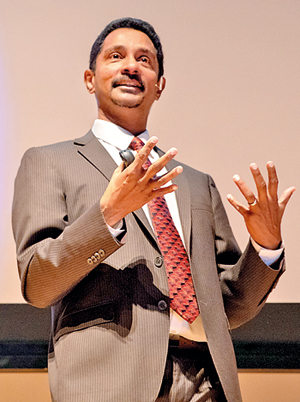Carl Sagan award for Dr. Ray

Dr. Ray Jayawardhana
In 1980s TV, there was a ‘black hole’ that sucked in a whole generation of young viewers, and spewed back scientists, space geeks, evolutionists and poets. This was Carl Sagan’s Cosmos: A Personal Voyage, a documentary series that brought to living rooms the fascinating mysteries of the universe.
Ray Jayawardhana was a teenager in Sri Lanka enthralled by the programme- something that prompted him to become an astrophysicist. Curiously he would go onto be a Professor of Astronomy at Cornell University where Sagan himself had worked.
Even more coincidentally Ray- this year- has just won the 2020 Carl Sagan medal offered by the American Astronomical Society- “for outstanding contributions to the dissemination of planetary science research to the general public.”
On receiving the medal, Ray says: “I’m humbled by the award and grateful to those who nominated me for it. It feels special to receive a medal named after Carl Sagan, who inspired me when I was a teenager, and to do so while I’m at Cornell, where he worked for decades.”
Ray was educated at St. John’s College Nugegoda and Royal College. He would go on to be- as of today- the Harold Tanner Dean of the Cornell University’s College of Arts and Sciences.
Dr. Ray as he is known has taught thousands of students at the University of Toronto- and his research accomplishments- particularly in the fields of exoplanets and planetary formation- are many. At Cornell he continues characterizing exoplanets, exploring the diversity of planetary systems, and investigating the origin and evolution of brown dwarfs, using the world’s largest telescopes and space observatories.
Ray’s research, writing and outreach have led to numerous accolades, including the Guggenheim Fellowship, Radcliffe Fellowship from Harvard, Rutherford Medal in Physics from the Royal Society of Canada, Nicholson Medal from the American Physical Society, and the Steacie Prize for Natural Sciences. Asteroid 4668 Rayjay is named after him.
But what the Carl Sagan medal celebrates is three decades of public outreach and engagement. As a compelling public speaker Ray has travelled the world bringing astronomy to diverse audiences through lectures and the media- while the four books he has brought to the world makes science almost as intriguing as a whodunit.
Star Factories: The Birth of Stars and Planets was his first book, while his second, Strange New Worlds, in 2011 brought readers news from the front lines of the epic quest to find planets–and alien life–beyond our solar system. He recounted the stories of the scientists and the remarkable breakthroughs that have ushered in the extraordinary new age of exploration, describing the latest findings–including his own–that are challenging our view of the cosmos and casting new light on the origins and evolution of planets and planetary systems. He revealed how technology is rapidly advancing to support direct observations of Jupiter-like gas giants and super-Earths–rocky planets with several times the mass of our own planet–and how astronomers use biomarkers to seek possible life on other worlds.
Neutrino Hunters: The Thrilling Chase for a Ghostly Particle to Unlock the Secrets of the Universe, looked at how “incredibly small bits of matter we call neutrinos may hold the secret to why antimatter is so rare, how mighty stars explode as supernovas and what the universe was like just seconds after the big bang”.
Child of the Universe, published March this year, is a children’s book. Illustrated by Raul Colón, it sparks a fascinating sense of wonder in a young reader- just like a planetarium does.
Ray says that “The beautiful pictures make it easier for a young child to share in that sense of magic, of grand possibilities: to be curious about what all this means.”
He hopes that the book will inspire young astronomers to push the boundaries of the universe as we know it.


